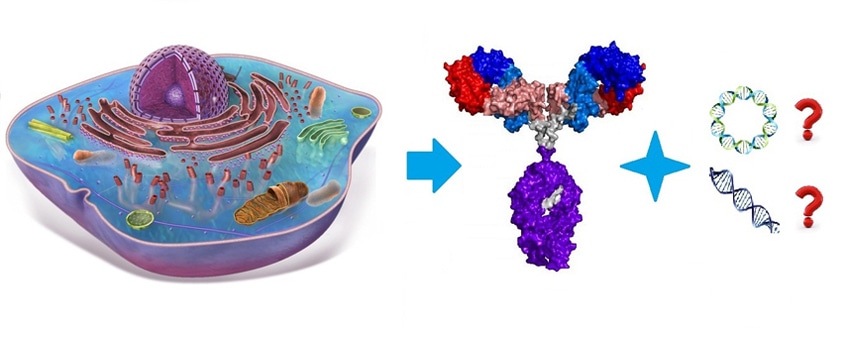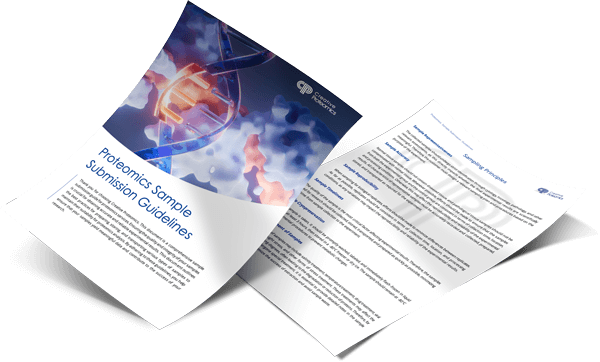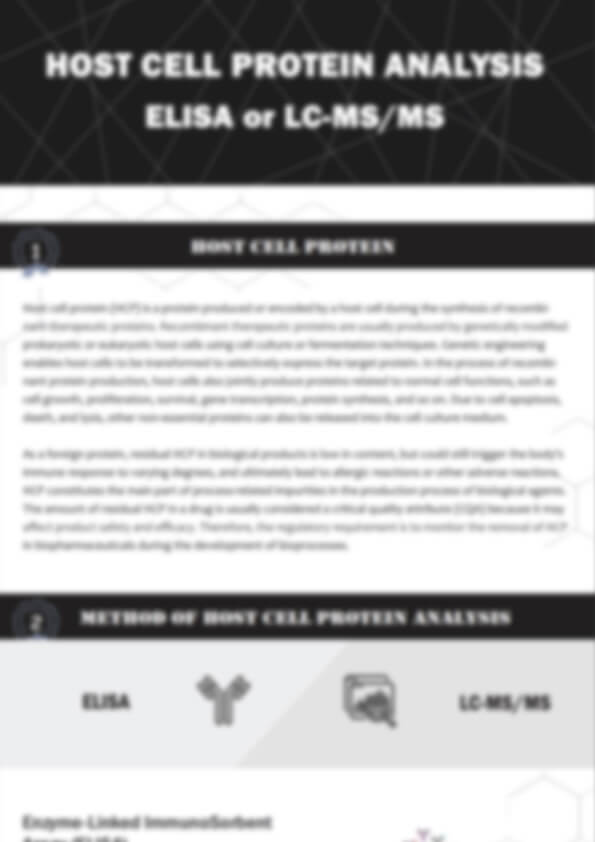Residual DNA Testing Services
Creative Protomics has developed a comprehensive residual DNA (rDNA) testing solution covering CHO, E. coli, Vero, and Pichia pastoris host cells. This advanced platform offers:
- High sequence specificity for accurate detection
- Exceptional sensitivity to identify even trace amounts of DNA
- Strong reproducibility ensuring consistent results
- High-throughput capabilities for efficient large-scale testing
These advantages make our solution widely adopted for residual DNA quantification in biopharmaceutical development and manufacturing.
Submit Your Request Now
×- Introduction
- Methods
- Solutions
- Advantages
- FAQ
Why Is Strict Control of Residual Host Cell DNA Essential?
In the current biotherapeutical industry, different host cells, such as CHO, hybridoma & engineered bacteria strains in the bio-reactors can be utilized for the manufacturing of protein therapeutics. But limited by current purification techniques, low levels of host DNA, in different sizes and physical forms, may still remain in the final products even after effective purification during manufacturing.

Residual host cell DNA refers to fragments or longer molecules of DNA that may remain in biologic products after manufacturing. These residual DNA fragments originate from host cells used in production and can pose significant risks, including:
Infection and Carcinogenicity Risks
Residual DNA may carry infectious viral genomes, such as HIV, which can integrate into human chromosomes, replicate, and generate infectious virus particles.
It may also contain oncogenes, potentially increasing the carcinogenicity risk of biologic products.
Immunogenicity Risks
Residual DNA can trigger pattern recognition receptors (PRRs), leading to nonspecific immune responses.
Studies have shown that high doses of nucleic acids (such as DNA vaccines or CpG oligodeoxynucleotides) can induce undesirable immune reactions.
Given these risks, regulatory agencies worldwide have established strict residual DNA limits for biologics. Pharmacopeias provide standardized testing methods to ensure compliance. Implementing robust residual DNA testing is crucial for monitoring the production process and ensuring the safety and quality of biopharmaceuticals.
Regulatory Standards for Residual Host Cell DNA
Global regulatory agencies have set strict limits on residual host cell DNA in biologic products to ensure safety and quality. Compliance with these standards is critical for regulatory approval, and various pharmacopeias outline validated testing methods for accurate DNA quantification.
Residual DNA Limits by Regulatory Guidelines
| Regulatory Authority | Product Type | Residual DNA Limit |
|---|---|---|
| U.S. FDA | Final biologic products | ≤10 ng/dose |
| Host cell-derived products | ≤100 pg/dose | |
| European Pharmacopeia | Host cell-derived products | ≤10 ng/dose |
| Inactivated hepatitis A vaccine | ≤100 pg/dose | |
| Hepatitis B vaccine | ≤10 pg/dose |
Comparison of Common Residual DNA Testing Methods
Selecting the right residual DNA testing method is essential for accurate quantification and regulatory compliance. Below is a comparison of widely used techniques:
| Method | Regulatory Guidance | Specificity | Sensitivity | Time Required | Detection Range |
|---|---|---|---|---|---|
| DNA Probe Hybridization | U.S. FDA, European Pharmacopeia | Medium | 10 fg/HL | 5-6 hours | 0.01-100 pg/μL |
| Quantitative PCR (qPCR) | U.S. FDA, European Pharmacopeia | High | 1 fg/HL | 1-1.5 hours | 0.01-100 pg/μL |
| Threshold Method | U.S. FDA | Low | 1 pg/HL | 0.5-1 hour | 1.25-80 pg/μL |
| Immunoassay (ELISA) | U.S. FDA | Low | 1 pg/HL | 0.5-1 hour | 1.25-80 pg/μL |
| Fluorescent Staining | European Pharmacopeia | Low | 1 pg/HL | 0.5-1 hour | 1.25-80 pg/μL |
Among these, quantitative PCR (qPCR) has become the gold standard due to its:
- High sensitivity and specificity for detecting trace DNA
- Accuracy and reproducibility in quantification
- Rapid turnaround time for efficient process monitoring
- Robust performance, unaffected by DNA fragmentation
Implementing qPCR-based residual DNA testing ensures compliance, product quality, and patient safety, making it the preferred method for bioprocess development and quality control.
Residual DNA Detection Solutions of Your Biopharmaceutical
To address the safety concerns associated with residual host cell DNA in biologics, Creative Protomics has developed a proprietary extraction and detection system. Our optimized qPCR protocol enables rapid and efficient quantification of residual DNA in biopharmaceutical products.
Quantitative PCR (qPCR) for Residual DNA Detection
Principle of qPCR-Based Residual DNA Testing
Quantitative PCR (qPCR) is a gold standard technique for measuring host cell DNA contamination in biologics. This method enables real-time monitoring of DNA amplification by detecting fluorescence signals from dye-based detection or probe-based assays.
When the fluorescence intensity reaches a predefined threshold, the initial DNA template concentration shows a linear correlation with the cycle threshold (Ct) value. By generating a standard curve using known DNA concentrations, the exact residual DNA amount in a sample can be accurately quantified.
Residual Host Cell DNA qPCR Testing Workflow
- Sample Preparation – Utilizes an advanced anti-interference lysis system for efficient sample processing.
- High-Efficiency DNA Extraction – Incorporates column membrane technology for maximum DNA recovery (≥95% yield).
- Real-Time Quantification – Uses a dual-control qPCR system for precise measurement.
- Data Analysis – Generates accurate quantification reports for regulatory compliance.
With its high sensitivity, specificity, and accuracy, qPCR has become the preferred method for biopharmaceutical process monitoring and quality control.
 Direct quantitative detection of host cell residual DNA by qPCR. (Gholizadeh-Hashjin, A., et al.; 2021)
Direct quantitative detection of host cell residual DNA by qPCR. (Gholizadeh-Hashjin, A., et al.; 2021)
Why Choose Our qPCR Detection Solution?
Our qPCR-based residual DNA testing offers a highly sensitive, specific, and reliable solution for biopharmaceutical quality control.
Key Advantages:
High Sensitivity & Accuracy – Detects DNA as low as 0.01 pg/μL with excellent reproducibility and batch-to-batch consistency.
Strong Specificity – Minimal cross-reactivity with non-target species, ensuring accurate results.
Robust & Versatile – DNA fragmentation does not affect detection outcomes, and the assay is compatible with standard PCR instruments.
Fast & Efficient – Pre-diluted calibration standards simplify qPCR setup, improving workflow efficiency.
Wide Linear Detection Range – Supports quantification from 0.01 to 100 pg/μL, maintaining high amplification efficiency.
Reliable Target Detection – Specific primers and probes ensure selective amplification of host cell DNA while resisting interference from foreign genomic fragments.
Consistent Results with Fragmented DNA – qPCR amplification and standard curve performance remain unaffected by DNA fragmentation, ensuring precise quantification.
Frequently Asked Questions (FAQ) on Residual DNA Testing
Why is qPCR becoming the gold standard for residual DNA detection?
qPCR offers pg-level sensitivity, high specificity, and meets pharmacopeial requirements for standard curve validation. It enables direct quantification, making it ideal for process monitoring in biologics manufacturing.
What could cause false-positive or false-negative qPCR results?
False positives – Sample contamination or primer dimer formation.
False negatives – Improper sample preparation (e.g., DNA degradation) or poorly designed primers.
How can I ensure the reliability of my qPCR assay?
Method validation should include:
Spike-recovery tests (acceptable range: 50%–150%)
Precision analysis (relative standard deviation RSD ≤30%)
Specificity testing (to exclude non-target DNA interference)
Learn about other Q&A.
References
- Li, S. M., Bai, F. L., Xu, W. J., Yang, Y. B., An, Y., Li, T. H., ... & Wang, W. F. (2014). Removing residual DNA from Vero-cell culture-derived human rabies vaccine by using nuclease. Biologicals, 42(5), 271-276. DOI: 10.1016/j.biologicals.2014.06.005
- World Health Organization. (1987). Acceptability of cell substrates for production of biologicals: report of a WHO study group [meeting held in Geneva from 18 to 19 November 1986]. WHO Technical Report Series, No. 747.
- Grachev, V., Magrath, D., Griffiths, E., & Petricciani, J. C. (1998). WHO requirements for the use of animal cells as in vitro substrates for the production of biologicals (requirements for biological substances No. 50). Biologicals, 26(3), 175-193. DOI: 10.1006/biol.1998.0153
- European Pharmacopoeia Commission. (2019). European Pharmacopoeia 9.8. Strasbourg: European Directorate for the Quality of Medicines & HealthCare.









